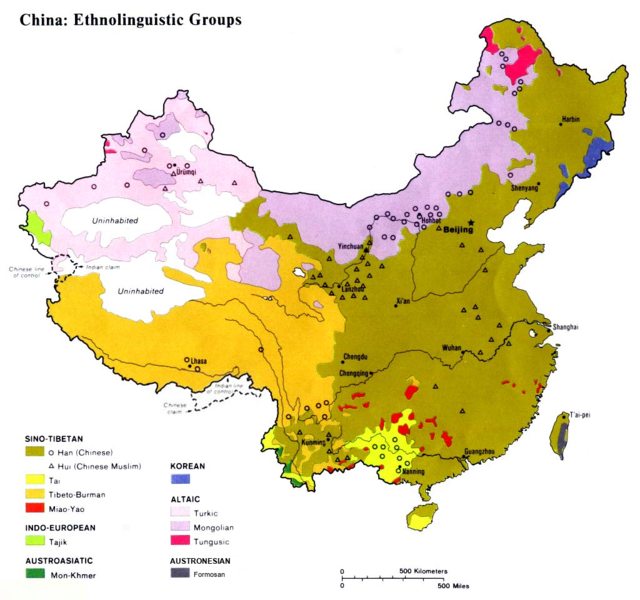Top Qs
Timeline
Chat
Perspective
List of ethnic groups in China
From Wikipedia, the free encyclopedia
Remove ads
The Han Chinese are the largest ethnic group in Mainland China. In 2010, 91.51% of the population were classified as Han Chinese (~1.2 billion).[1][needs update] Besides the Han Chinese majority, 55 other ethnic (minority) groups are categorized in present-day China, numbering approximately 105 million people (8%), mostly concentrated in the bordering northwest, north, northeast, south and southwest but with some in central interior areas.


The major ethnic minorities in China are the Zhuang (19.6 million), Hui (11.4 million), Uyghurs (11 million), Miao (11 million), Manchus (10.4 million), Yi (9.8 million), Tujia (9.6 million), Tibetans (7 million), Mongols (6.3 million), Buyei (3.5 million), Dong (3.5 million), Yao (3.3 million), Bai (2 million), Koreans (1.7 million), Hani (1.7 million), Li (1.6 million), Kazakhs (1.5 million), and Dai (1.2 million).[2] In addition, there are a number of unrecognized ethnic groups which together comprise over 730,000 people. Collectively, the ethnic groups of China are referred to as the Zhonghua minzu (Chinese: 中华民族; pinyin: Zhōnghuá mínzú; lit. 'Chinese ethnicity'). However, being part of the Zhonghua minzu (i.e. being part of one of the 56 ethnic groups) does not necessarily mean one must have Chinese nationality (Chinese: 中国国籍; pinyin: Zhōngguó guójí) or be loyal to the People's Republic of China.
Remove ads
Officially recognized groups
Summarize
Perspective
Officially recognized ethnic groups receive or have received certain benefits over Han Chinese under the regional ethnic autonomy system, including affirmative action, exemptions from the one-child policy, designated seats in political organs and government support to preserve their culture. Ethnic minority autonomous areas receive additional state subsidies.[3][4] Languages of officially recognized minorities are used in official government documents.[5][non-primary source needed]
Soon after the establishment of the People's Republic of China, 39 ethnic groups were recognized by the first national census in 1954. This further increased to 54 by the second national census in 1964, with the Lhoba people added in 1965. The last change was the addition of the Jino people in 1979, bringing the number of recognized ethnic groups to the current 56. The following are the 56 ethnic groups (listed by population) officially recognized by the People's Republic of China.[6]
- The population only includes mainland China.
- This category includes several different Tai-speaking groups historically referred to as Bai-yi. In fact, the Dai nationality consists of speakers of varieties of Shan languages. For instance, the Tai Lue and Tai Nuea peoples are actually subgroups of the Shan people. Despite this, speakers of Bumang are also included in the Dai nationality.
- They are not Tajik people but Pamiri people.
- The same group as Vietnamese or Kinh people in Sino-Vietnamese.
- A collective name for all Taiwanese aborigine groups in Taiwan. In fact, the numbers of Gaoshan in census covers only those who lives in mainland China (mainly in Fujian) and consists of Amis (autonym: Pangcah), Paiwan and Bunun peoples.[citation needed]
Remove ads
Unlisted ethnic groups
Summarize
Perspective
This section needs additional citations for verification. (March 2024) |
The following ethnic groups living in China are not recognized by the Chinese government:
- Äynu people – classified as Uyghurs
- Altai people – classified as Mongols[10]
- Fuyu Kyrgyz people – classified as Kyrgyz
- Gejia people – classified as Miao
- Bajia (八甲人; Bājiǎrén)
- Deng people
- Hu people – classified as Bulang
- Khmu people – classified as Bulang
- Kucong
- Mảng people
- Ili Turk people – classified as Uzbek
- Sherpa people – classified as Tibetan
- Tanka people, including Fuzhou Tanka
- Tebbu people
- Tuvans – classified as Mongols[11]
- Waxiang people
- Jewish people
- Macanese people, mixed race Catholic Portuguese speakers who lived in Macau since 16th century of various ethnic origins
- Utsuls – classified as Hui
- Yamato people and Ryukyuan people, primarily Japanese settlers that remained in China after the Second Sino-Japanese War, which mostly were women and orphaned children[12]
During the Fifth National Population Census of the People's Republic of China held in 2000, 734,438 people on the mainland were recorded as belonging to "undistinguished ethnic groups"—of these, 97% resided in Guizhou.[13][needs update]
Remove ads
Hong Kong and Macau
Hong Kong and Macau are special administrative regions within China. The governments of Hong Kong and Macau do not use the official PRC ethnic classification system, nor does the PRC's official classification system take ethnic groups in Hong Kong and Macau into account. Minority groups such as Western Europeans (mainly English and Portuguese), and Southern or Southeastern Asians (mainly Filipinos, Indians, Indonesians, Nepalese, and Pakistanis) live in Hong Kong.[14] Macau's main ethnic groups are of Chinese and Portuguese descent, but other ethnicities also live in the territory.[15]
Gallery
See also
- 56 Flowers
- Affirmative action in China
- Demographics of China
- Demographics of Taiwan
- Local ethnic nationalism
- Taiwanese people
- Ethnic minorities in China
- Han Chinese subgroups
- Hua–Yi distinction
- Languages of China
- List of endangered languages in China
- Kra–Dai ethnic groups in China
- Taiwanese indigenous peoples
- Unrecognized ethnic groups in China
- Minzu (anthropology)
Remove ads
References
Further reading
External links
Wikiwand - on
Seamless Wikipedia browsing. On steroids.
Remove ads








